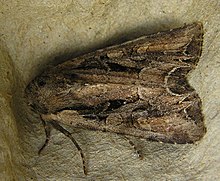Lacanobia thalassina, the pale-shouldered brocade, is a moth of the family Noctuidae. It is found in Europe east across the Palearctic to the Russian Far East and Siberia.[1]
| Lacanobia thalassina | |
|---|---|

| |
| Scientific classification | |
| Domain: | Eukaryota |
| Kingdom: | Animalia |
| Phylum: | Arthropoda |
| Class: | Insecta |
| Order: | Lepidoptera |
| Superfamily: | Noctuoidea |
| Family: | Noctuidae |
| Genus: | Lacanobia |
| Species: | L. halassina
|
| Binomial name | |
| Lacanobia halassina (Hufnagel, 1766)
| |
Technical description and variation
editThe wingspan is 35–38 mm. The length of the forewings is 16–20 mm. Has no pale grey tints; the red-brown ground colour varying only to dark grey; the claviform (club-shaped) stigma is produced as a dark dash to outer line; upper stigmata pale with partial black outlines, a black basal streak with pale patch above it; hindwing pale fuscous, paler at base; the form achates Hbn. has the forewing uniform red brown; while humeralis Haw. is fuscous grey with the red tints absent; ab. nigrifusa nov. [Warren] is wholly suffused with black, the orbicular stigma and traces of outer and submarginal lines remaining pale grey.[2]
Similar species In Lacanobia suasa and Lacanobia w-latinum, the W sign of the wavy line extends to the fringes. [3] [4]
Biology
editThe moth flies in two generations from early May to September[1].
Larva green or reddish yellow, with two dark oblique stripes on each segment, with two dark spots or blotches in front of them; lateral lines pale grey with red edges. The larvae feed on various deciduous trees and plants: Betula sp., Alnus incana, Salix sp., Polygonum spp., Chenopodium album, Delphinium sp., Berberis sp., Brassica spp., Rubus idaeus, Sorbus aucuparia, Pisum sativum.[5] Found in very different habitats - forest, meadow, heath and moorland areas as well as in urban gardens and parks. In the mountains, it rises to an altitude of about 1600 meters.
Notes
edit- ^ The flight season refers to Belgium and The Netherlands. This may vary in other parts of the range.
References
edit- ^ Colour Atlas of Siberian Lepidoptera
- ^ Seitz, A. Ed., 1914 Die Großschmetterlinge der Erde, Verlag Alfred Kernen, Stuttgart Band 3: Abt. 1, Die Großschmetterlinge des palaearktischen Faunengebietes, Die palaearktischen eulenartigen Nachtfalter, 1914
- ^ Hermann Hacker, László Ronkay & Márton Hreblay: Noctuidae Europaeae, Volume 4, Hadeninae I, Entomological Press, Søro 2002, ISBN 87-89430-07-7, S. 61/62
- ^ Walter Forster, Theodor A. Wohlfahrt: Die Schmetterlinge Mitteleuropas, Band 4, Eulen (Noctuidae)., Franckh’sche Verlagshandlung, Stuttgart 1971, ISBN 3-440-03752-5, S. 74
- ^ "Robinson, G. S., P. R. Ackery, I. J. Kitching, G. W. Beccaloni & L. M. Hernández, 2010. HOSTS - A Database of the World's Lepidopteran Hostplants. Natural History Museum, London".
External links
edit